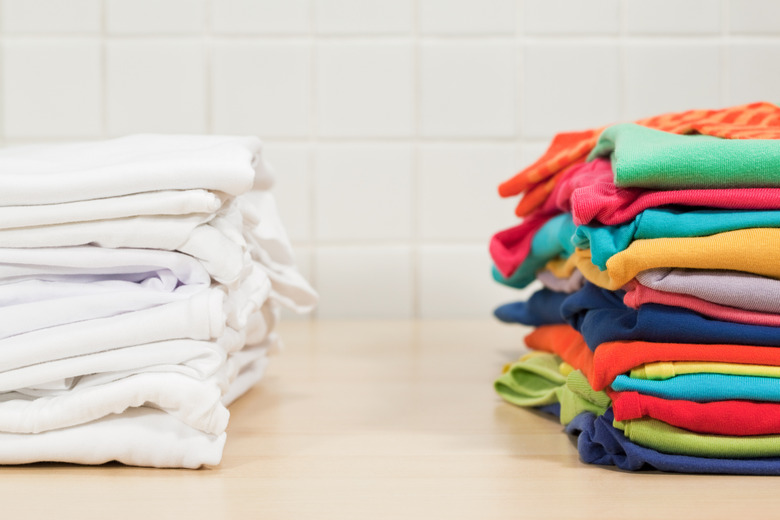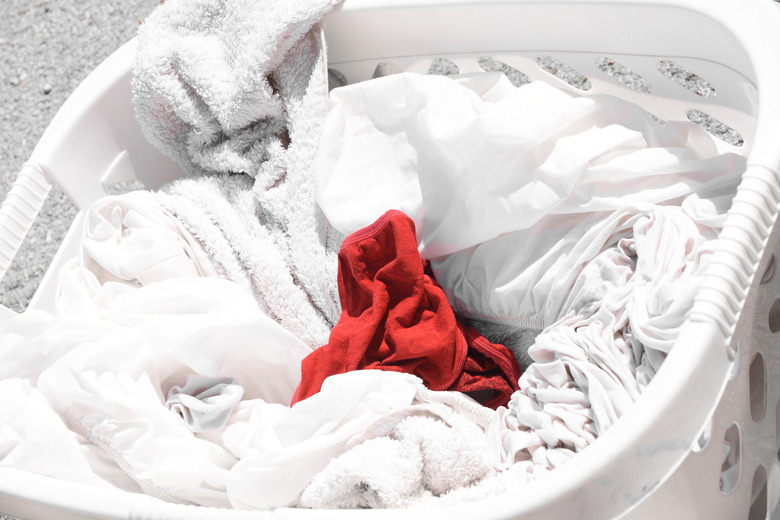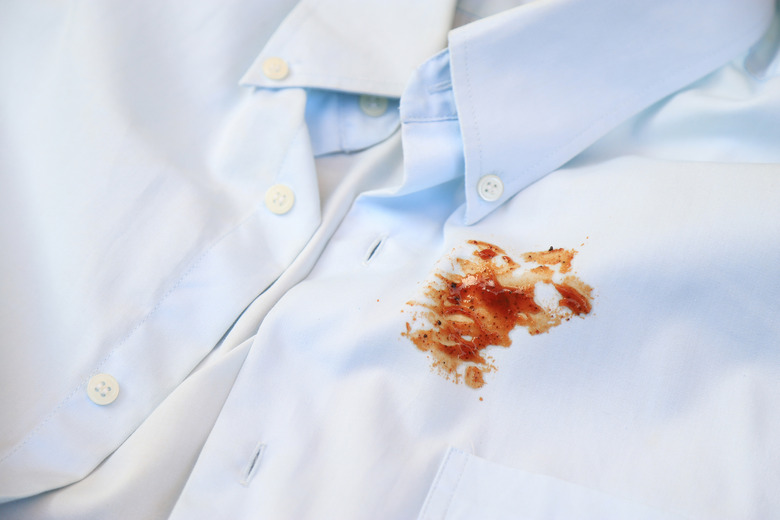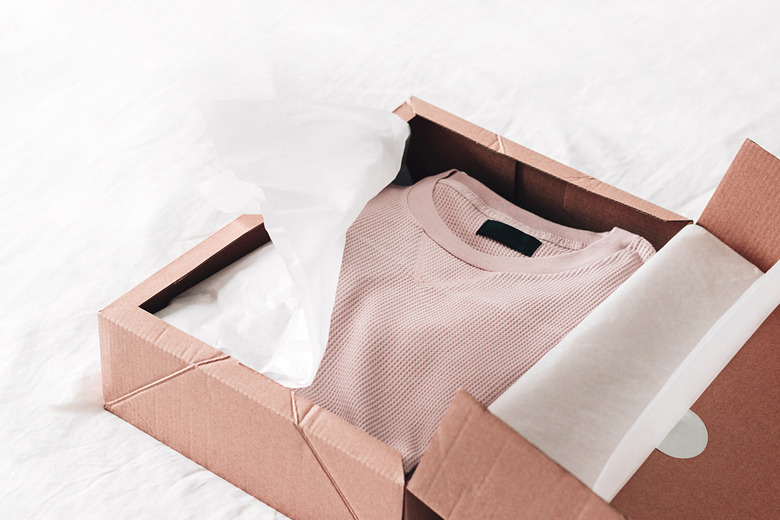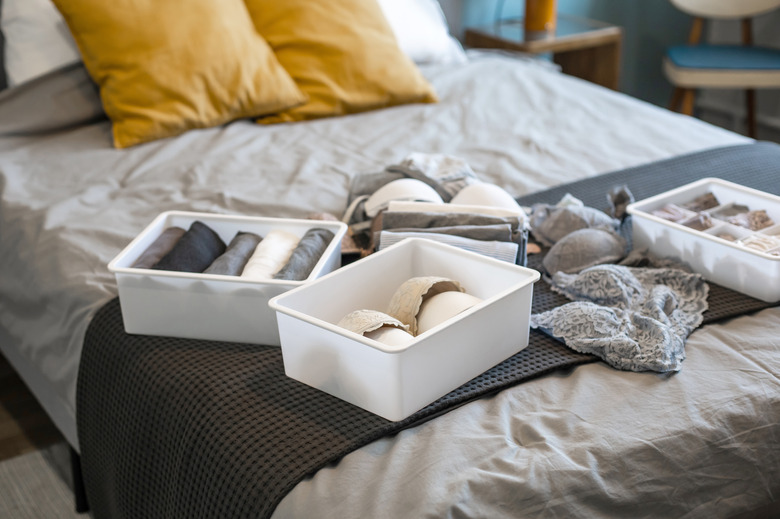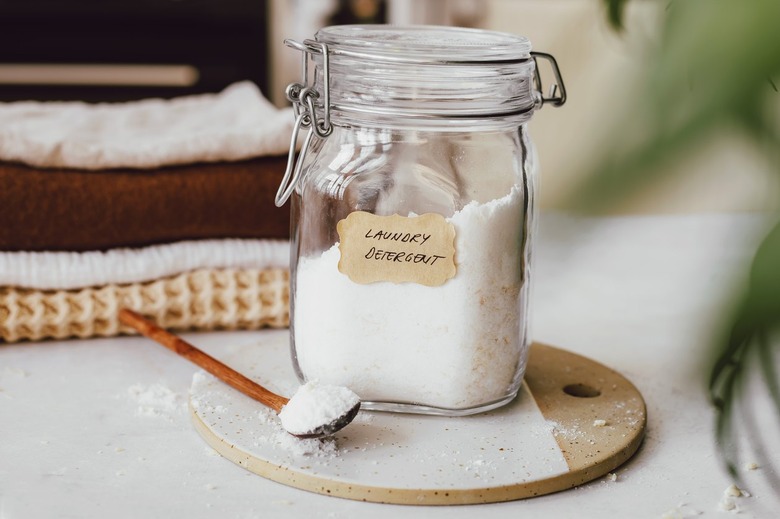How To Separate Laundry Like A Pro
We may receive a commission on purchases made from links.
Washing your clothing isn't difficult, but your items will last longer if you learn how to separate laundry properly just like your grandma taught you. Color, fabric type, and soil level can all impact what you should wash together and what you shouldn't. And if you get a hamper or laundry basket with a divider, you can easily sort your clothing when you undress at night so you don't add sorting time to laundry day.
Sorting by Color
Sorting by Color
The conventional approach to sorting laundry by color involves three loads: dark colors, light colors, and whites. This prevents dark colors from bleeding into light colors and allows you to bleach your whites as necessary without the risk of accidentally bleaching other clothes. Color sorting also accounts for various water temperature needs. Dark colors do best in cold water, light colors do best in warm or cold water, and whites do best in hot water.
It's true that washing dark clothing or linens separately helps prevent them from bleeding into lighter clothes, but the color sorting system also protects the dark colors. Lint tends to stand out on blacks and other dark shades, so you don't want to wash darks with lint-producing light colors. If you do, you may find yourself reaching for a lint roller as soon as your dark colors come out of the dryer.
How to Test for Colorfastness
Sometimes, you may want to toss a colorful item into a load of laundry for expediency, but you're not sure whether you should. Here's how to test for colorfastness:
- Combine 1 cup of warm water and a teaspoon of laundry detergent.
- Dampen a discreet area on a dark colored item with the soapy water and allow the sock to sit for two or three minutes.
- Then, press a white towel into the dark colored clothing item. If the towel stays clean, the item is colorfast. If not, avoid washing the item you tested with lighter colors.
Sorting by Fabric Type
Sorting by Fabric Type
Different fabrics don't always play well together in the washing machine. Heavy, highly textured items, like bath towels, can abrade lighter, smoother items, like bedsheets, leading to pilling and wear of the smoother fabrics. Putting your super-soft leggings in the washing machine with a load of heavy blue jeans is like rubbing sandpaper on them.
This goes for high-tech workout clothes as well. Modern workout wear is great for wicking away moisture as you exercise and keeping you comfortable, but that means a lot of polyester, nylon, Lycra, and other materials that deteriorate quickly when washed with more abrasive fabrics. And since you wash your gym clothes often, they can deteriorate quite rapidly if washed improperly.
When sorting by fabric type, remember to take into account any extras. You may find zippers, buttons, snaps, and other potentially abrasive items attached to an otherwise delicate fabric. In that case, you will need to do a separate wash cycle for these items or wash them in a mesh laundry bag that will keep the hardware from making direct contact with other items in the load.
Need another reason to separate your laundry by fabric type? Heavier fabrics take longer to dry. Drying heavy fabrics with lighter ones can result in overdrying the lighter fabrics. This stresses the fibers in the fabric and reduces the life span of your clothes.
Sort By Soil Level
Sort By Soil Level
If you've just spent the day wrenching on your car and your jeans are covered in oil, it's best to wash them by themselves or with other really dirty items. You don't want the oil finding its way onto your favorite dress shirt by putting it into the wash with your jeans. Heavily soiled items should be washed alone or with other heavily soiled items.
This brings us back to your gym clothes. Hopefully, a good washing will eliminate any stinky odors, but on occasion, the unpleasant smells can linger even after the laundry is finished. You can solve this problem by soaking your workout duds in a water and white vinegar solution for 30 minutes. Washing your workout clothes separately allows you to do this if necessary and prevents any lingering odors from creeping into your everyday clothes.
Caring for New Clothes
Caring for New Clothes
Sometimes, new clothes may require a little extra attention. New clothes are far more likely to bleed dye onto the other items in the wash, even if they're not red or dark. A new yellow or pink T-shirt can still spread some unwanted color onto your whites or other light colors. As such, it's a good idea to wash new clothes separately a few times before merging them into your regular wash routine.
Dealing With Delicates
Dealing With Delicates
Some fabrics are so delicate that they need sorting into their own laundry pile to receive special attention. These are the dreaded items that need to be hand-washed. But if you're not the type who finds hand-washing to be a therapeutic escape, a mesh wash bag can be your best friend.
Serving as a protective skin around your finer fabrics, a mesh bag keeps clasps, strings, and straps from getting wound up and pulled by the rest of the laundry. This enables you to wash many delicates in your washing machine without fear of damaging them. This can save you from a lot of hand-washings over the years. You should still wash delicate items by themselves, however, even when they are in a bag.
That said, for anything that's super delicate or very specifically has "hand-wash only" on the care label, do wash the item by hand with a mild detergent, like Woolite. Don't wring it out, as this is hard on the garment. Instead, just ball it up and squeeze it for several seconds. Then, if desired, press the garment between two clean towels to soak up any excess water. Finally, hang it or lay it flat to dry, as appropriate.
Does Detergent Type Matter?
Does Detergent Type Matter?
After all this talk about how to separate laundry based on the different needs of different fabrics, you may be wondering if you need more than one type of detergent. Detergent type can matter in a few different ways.
First, if you have a front-loading or high-efficiency top-loading washing machine, use only "HE" (high-efficiency) detergent, which is formulated for low suds. Second, don't use fabric softener or detergents containing fabric softener to wash fire-retardant garments, such as baby sleepers or children's pajamas. Fabric softeners have been shown to reduce fire-retardant properties in fabric.
Bleach matters as much as detergent. You can use color-safe bleach (which usually has "oxy" in the name or is labeled "oxygen bleach") on colors but don't use conventional chlorine bleach on anything but white clothing or linens. Chlorine bleach kills colors and is hard on synthetic fabrics and elastic.
What if I Don't Separate My Laundry?
What if I Don't Separate My Laundry?
So, now you know how to separate laundry, but what happens if you're feeling tired and lazy one night and you skip the sorting? Maybe nothing. You wouldn't be the first person to throw together a haphazard load of laundry and have everything turn out just fine. But you might not always be so lucky.
Everyone has heard horror stories about a rogue red sock turning a load of whites pink. This can happen with any dark or vibrant color. Dye bleeding from one garment to another and discoloring it does happen. Combining the wrong fabrics or colors can also leave some items covered with lint or fabric pilling. Mixing heavy fabrics with knits is also a recipe for misshapen and stretched-out clothing.
Even if your clothes come out looking fine, there may be damage to the fibers that you can't see. The process of washing and drying your clothes will always wear down the fabric over time, but rubbing abrasive materials together speeds the process. Failing to sort your laundry may cause some of your clothes to wear out prematurely.
